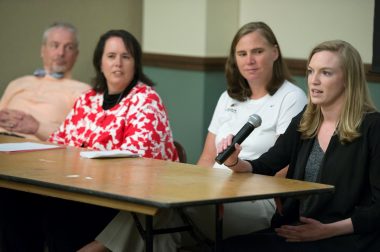As part of the 2nd Annual Elon BrainCARE Symposium, an Elon panel explored the reasons that led to the implementation of a safer protocol when determining return-to-play and return-to-learn decisions at the university.

Though she could not see right after the impact, had difficulty getting up and felt foggy, she finished the practice as if nothing had happened. But when she tried to study that night and found herself falling sleep for 14 hours instead, she knew something wasn’t right.
She confided in her roommate, Kelsey Evans ’13, an Elon basketball player and exercise science major who was doing research with Professor of Exercise Science Eric Hall and Elon BrainCARE—an interdisciplinary program that focuses on concussion assessment, research and education. Evans recognized the signs of a concussion and urged Ledbetter to report them to the volleyball’s team trainer, Marty Baker.
It took Baker less than five minutes to reach the same conclusion. “She was not Carly,” he recalled. “You could see it in her eyes.”
While no two concussions are alike, most athletes battle with symptoms for 10 days or so. For Ledbetter, what followed were months of struggling both physically and emotionally with the effects of her invisible injury. She received full support from Hall, who worked with her through BrainCARE, and the athletics staff, and was monitored constantly to make sure she was not put on the court until she was truly ready. In the classroom, however, she was left to try to keep up on her own.
For the most part, her professors understood her predicament, but they soon started demanding more. A double major in history and communications with a minor in women’s gender studies, Ledbetter was used to getting A’s and wanted to preserve her 3.9 GPA. The two Bs she received the semester she was recovering from her concussion brought her GPA down, a frustrating experience that left her hoping more could be done in the future so other athletes would have an easier time coping.
Others at Elon hoped for the same, and decided to do something about it. “Carly’s experience was basically ‘patient zero’ for us,” Baker said during a panel discussion May 8 as part of the 2nd Annual Elon BrainCARE Symposium, a daylong event designed to educate the Elon community about concussion treatment and management. “We realized we had to do something better to support these kids, especially that small percentage of student-athletes who struggle beyond day 10.”

Prior to the new protocol, there was a disconnect between when students were medically cleared to play and when they were cleared to return to academics, something that caused confusion, said Mary Tendler, head women’s volleyball coach. She is now more attuned to her player’s academic performance to ensure no students are left on their own. She said she realizes the competitive nature of athletes often pushes teammates to be critical of injured students for not being tough enough. The new protocol helps them see it’s not solely up to a player to determine when to return to the court or field.
Looking ahead, those working with concussions would like to add the help of a sport’s psychologist to the process to work with students like Ledbetter, whose symptoms linger for months. In hindsight, she said, a sport’s psychologist would have probably recognized the depression-like symptoms the concussion brought about and treated them accordingly instead of dismissing them as senior blues as she did at the time. “I didn’t want to continually blame the concussion,” she said. On a brighter note, she is glad to know her experience has led to so many changes at Elon. “It’s great that there is already a protocol in place,” she added.
While there is always room for improvement, the protocol is ensuring student-athletes have a better college experience on and off the field, Hall said. “To treat a concussion, it’s a team approach.”
Baker agreed. “What we are doing is based on best practices,” Baker said, “but also based on what’s best for athletes” during their years as students and beyond. “I want us to win, because a winning team is a healthy team,” he added. “But at the end of the day, what I need to be more concerned about is their well-being and safety.”


